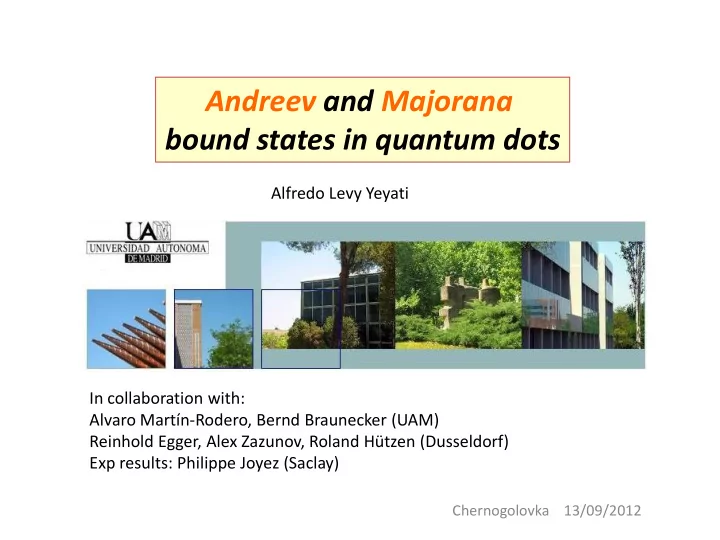

Andreev and Majorana bound states in quantum dots Alfredo Levy Yeyati In collaboration with: Alvaro Martín-Rodero, Bernd Braunecker (UAM) Reinhold Egger, Alex Zazunov, Roland Hützen (Dusseldorf) Exp results: Philippe Joyez (Saclay) Chernogolovka 13/09/2012
e QW 2e S h Andreev states spectroscopy in CNTs Search for Majorana states in semiconducting nanowires J.D. Pillet et al. Nature Phys. (2010) V. Mourik et al. Science (2012) Effect of e-e interactions Charging energy in QD regime
Outline Andreev states in QDs The superconducting Anderson model Experimental results – Fit by model calculations NRG vs mean field results Majorana bound states in QDs The single charge Majorana transistor Transport properties: Known limits Weak blockade regime General Green functions formalism Zero band width limit Equation of motion method Master equation approach Conclusions
QD regime: the superconducting Anderson model Single Level 0 U 2 2 H n U n n t c d h . c . H H 0 k k L R 0 L R k , i / 2 H c c e c c h . c . L , R k k k k k k , k p -junction behavior! , , U , , , eV L R 0 L R Equilibrium (V=0): Kondo vs Pairing crossover T K Energy scale : ~ Energy scale : ~ Review: A. Martín-Rodero & ALY, Adv. Phys. (2011) k b T K
Spectral properties: Andreev bound states
Experimental results: gate voltage dependence
ABS in SC Anderson model: Hartree Fock approximation H n U n n t c d h . c . H H 0 k k L R k , . 0 5 0 1,0 0,50 U n E ex 0 . 25 0 0,5 I/(4 p e /h) 0,25 HF approx. E/ 0,0 0,00 U d d ind -0,25 -0,5 E ex -0,50 -1,0 1,0 0,50 E ex 0 . 75 2 I/(4 p e /h) Breaking spin 0,5 n 0,25 n E/ symmetry 0,0 0,00 -0,25 -0,5 -0,50 -1,0 1,0 0,50 E ex 1 . 50 I/(4 p e /h) 0,5 E 0,25 E/ Minimal model ex 0,0 0,00 0 -0,25 -0,5 ind -0,50 -1,0 (pheonomenological parameter) 0,0 0,5 1,0 1,5 2,0 0,5 1,0 1,5 2,0 / p / p E. Vecino, A. Martín-Rodero, A. Levy Yeyati, PRB 68 , 035105 (2003)
Fitting the experimental data: gate voltage dependence Exp. Model J.D. Pillet, Ch. Quay, C. Bena, A. Levy Yeyati and P. Joyez, Nature Phys. (2010)
ABS in SC Anderson model: Mean field vs “ exact ” results A. Martín-Rodero & ALY, J. Phys: Cond. Matter (2012)
Numerical Renomalization Group: basic ideas D Logarithmic discretization Map into semi-infinite chain V V V V 0 1 2 4 N / 2 V N Iterative diagonalization Truncation: #states < N c
ABS: HF vs NRG results 4 Dashed: HF, Full: NRG N 300 c p phase: 4 ABSs
ABS: HF vs NRG results Dashed: HF, Full: NRG p phase
Symmetric case Dashed: HF, Full: NRG
Quantum dots with Majonana bound states A. Zazunov, ALY & R. Egger, PRB (2011) R. Hützen, A. Zazunov, B. Braunecker, ALY & R. Egger, arXiv:1206.3912
Majorana generation: induced superconductivity in normal or topological semiconducting wires Review: J. Alicea, arXiv:1202.1293 V. Mourik et al. (Delft) Science (2012) Helical states in TI nanowires R. Egger, A. Zazunov, and ALY, PRL (2010)
The Majorana Single Charge Transistor g L g R E , , T c L , R “Non - local” fermion Cooper pairs number
Known limits Bolech & Demler, PRL (2007) “ resonant Andreev reflection ” L. Fu, PRL (2010) “ electron teleportation ”
Model Hamiltonian A. Zazunov, A.L.Y. & R. Egger, PRB (2011) Equivalent representation: Cooper pairs + d fermion N ( N , 0 ) ( 1 , 1 ) ( N , 1 ) ( N , 0 ) “ anomalous ” tunneling (Cooper pair splitting) “normal” e tunneling
Weak blockade regime A. Zazunov, A.L.Y. & R. Egger, PRB (2011) Relevant dregree of freedom Keldysh path integral formulation Second order expansion equivalent to semi-classical Langevin equation Current in “P(E)” form
Keldysh GFs formulation: general current formula Define Nambu spinors Exact current formula!
Linear conductance: evaluation within ZBWM d e i d R L
Evaluation using EOM (Equation of Motion method) Truncation Self-consistency
EOM results e-spectral density “h” -spectral density
Crossover of peak conductance
Finite temperature: Master equation approach ( EC ) j , Q Q ( seq ) ( seq ) j , Q Q 1 j , Q Q 1 Q-2 Q-1 Q Q+1 Q+2 ( AR ) ( AR ) j , j ' , Q Q 2 j , j ' , Q Q 2
Results from Master equation approach 2 T CB oscillations Peak conductance
Finite voltage sideband peaks
Conclusions Andreev bound states in QDs * Qualitative description of CNTs results using phenomenological models * Validity of mean field (HFA): good agreement with NRG for T K Majorana Single Charge Transistor * Insight from several different methods (WB, ZBWM, EOM, ME) * Crossover of peak conductance from 2e 2 /h to e 2 /h as a function of E c / * Coulomb blockade oscillations and side band peaks in non-linear conductance * Work in progress: consequences for non-local transport (crossed Andreev)
Recommend
More recommend